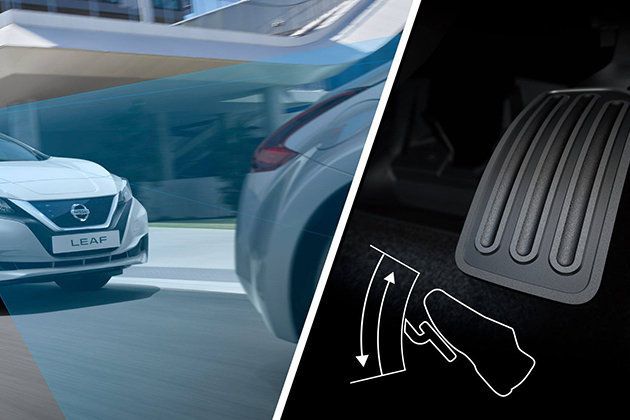When the new Nissan LEAF first hit the roads back in 2010, it took electric vehicles from a niche interest into a mainstream reality, going on to become the world’s best-selling EV.
Owners have found it to be a great all-rounder. Its green credentials may have been why people bought the car initially, but it’s clear from surveys that what surprised so many was the performance, especially the rapid acceleration and fantastic handling, which went to make it such a fun car to drive.
Its latest incarnation, due to launch in Europe in January 2018, is set to revolutionise our automotive landscape once again. Where the original LEAF radically altered our assumptions about the kind of car we drive, this new version will transform the way in which we drive.
Why? Because when you’re driving you’ll no longer be moving your right foot from accelerator to brake and back again. Instead, thanks to the e-Pedal, your foot will stay planted in exactly the same spot to execute both actions.

How does the e-Pedal work?
Francesco Giacalone, Nissan Europe’s electric vehicle product Marketing director, knows this radical new technology intimately, and he explains how it works.
“It’s extremely simple really,” he says. “With a normal car, to slow down you need to move from accelerator to brake, then back to the accelerator to speed up again. With the e-Pedal you push down on the pedal to accelerate and ease off to brake. You can even bring the car to a complete stop by removing your foot sharply.”
The new Nissan LEAF does still come with a brake pedal, of course, although this is only used when the driver wants to brake more aggressively or come to an emergency stop. The e-Pedal is activated by a switch on the central dashboard, and the chances are you’ll keep it in this mode for most of your driving.
What are the advantages of the e-Pedal?
“One of the biggest advantages of the new e-Pedal is it improves the efficiency of the LEAF’s regenerative technology,” says Francesco. “With a fully electric powertrain you can exploit both brake and regenerative energy in the smoothest possible way.”
Regenerative technology is where, under braking or deceleration, energy created by the car’s movement is ‘recycled’ and sent back to recharge the battery. Regenerative braking has been around for a long time, and in the previous LEAF the B Mode further enhanced the car’s regenerative capacities.
“The e-Pedal is an evolution of the B Mode,” says Francesco. “When you lift your foot off the accelerator, the car is already in braking mode, so it automatically maximises the regeneration through braking. Previously, you would be switching back and forth between accelerator and brake pedal and would lose some regenerative capacity that way. Now you exploit 100 percent of it.”
Getting used to the e-Pedal
What about getting used to using the e-Pedal? Given we’re so familiar with using two pedals (in an automatic) or three pedals (in a manual), won’t our feet be fumbling around in the foot well after a pedal we no longer need?
“The feedback we get from testing is that once you’ve driven for about 15 minutes with this system, you’re all set,” says Francesco. “After that point it becomes the way you want to drive. For me it’s like going from using an old smartphone with the full keyboard to a smartphone with a totally digital touchscreen. Once you try the touchscreen, you won’t want to go back to the older technology.”

What change will the e-Pedal make to everyday driving?
The e-Pedal is particularly useful in stop-start traffic says Francesco. “In commuting you might drive for 100 meters then brake, then drive for 20 meters then brake and so on – this shifting back and forth between accelerator and brake is happening a lot.
“In tests Nissan undertook with nearly a thousand drivers using the e-Pedal on their everyday journeys, what we discovered is that this back and forth action between accelerator and brake is reduced by a massive 90 percent.”
There will be major advantages to people who use cars on a professional basis, like taxi drivers or people who use the vehicles for deliveries and so on. “Driving this way becomes much more smooth, fluid and natural,” says Francesco. “It makes driving much less stressful, and for anyone who’s job means they have to spend hours driving around towns and cities, it will be a massive benefit.”
What else can we look forward to from the e-Pedal?
Electric vehicles are often criticised by petrol heads for lacking driver involvement, but the e-Pedal will turn that assumption on its head, according to Francesco.
“On fun, winding roads where there is little traffic, using the e-Pedal almost feels like motorbike-style driving, making the car more sporty. When you approach a corner you lift your foot off the accelerator to brake – the braking uses an intelligent system that regulates the brakes and wheels – then without removing your foot from the pedal you can start to accelerate out of the corner. It’s a safe, fun drive that delivers excitement.”
The new Nissan LEAF’s battery pack sits low in the chassis, so this also helps the car hug the road, while the new, sleeker design reduces drag and lift on the car, giving it even more stickiness on the road for that sportier experience, should you want it. So, the fun driving characteristics that so surprised buyers of the original LEAF are not only still there, they’ve been taken to a whole new level.
“Nissan’s commitment is to constantly innovate but to make this innovation available to as many customers as possible,” concludes Francesco. “So the e-Pedal, isn’t an add-on you pay extra thousands of Euros for, it’s available at entry-level on the new Nissan LEAF, so it’s about bringing this excitement to everyone.”